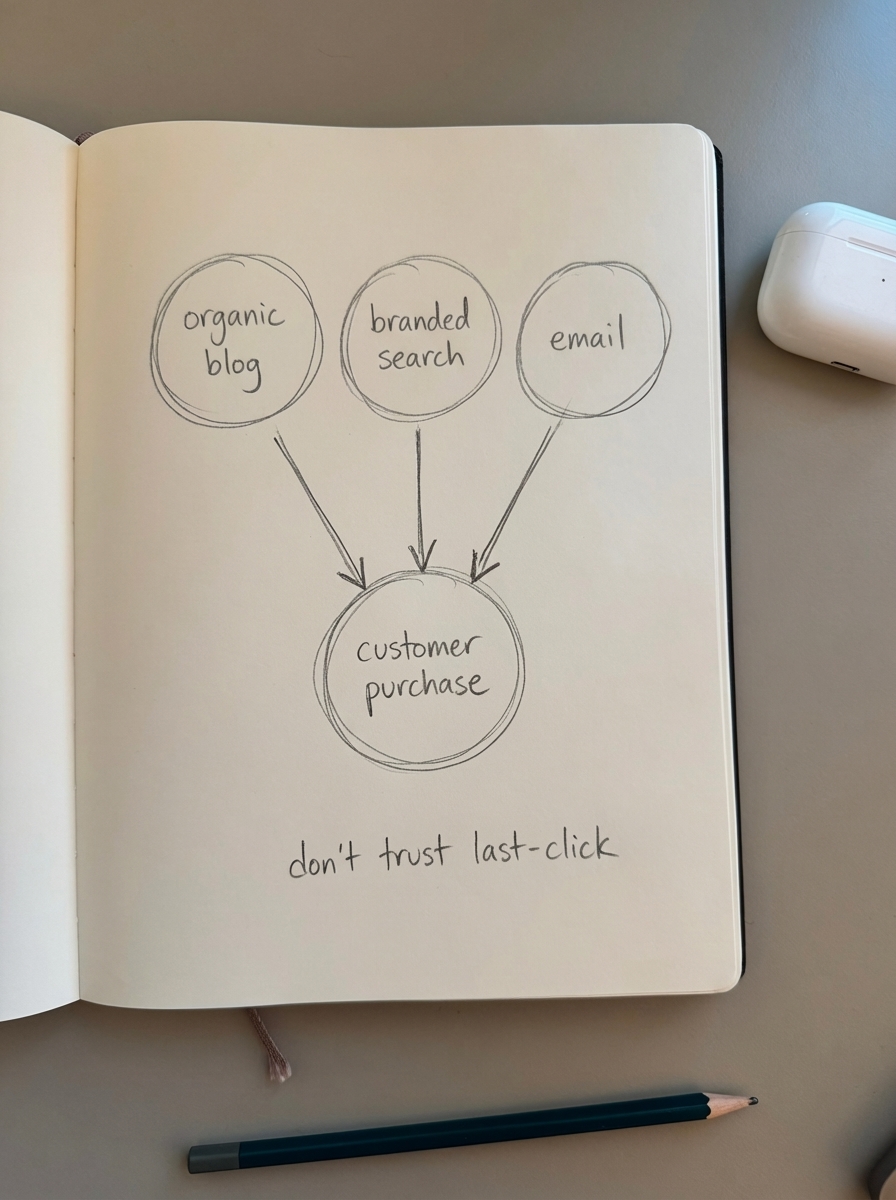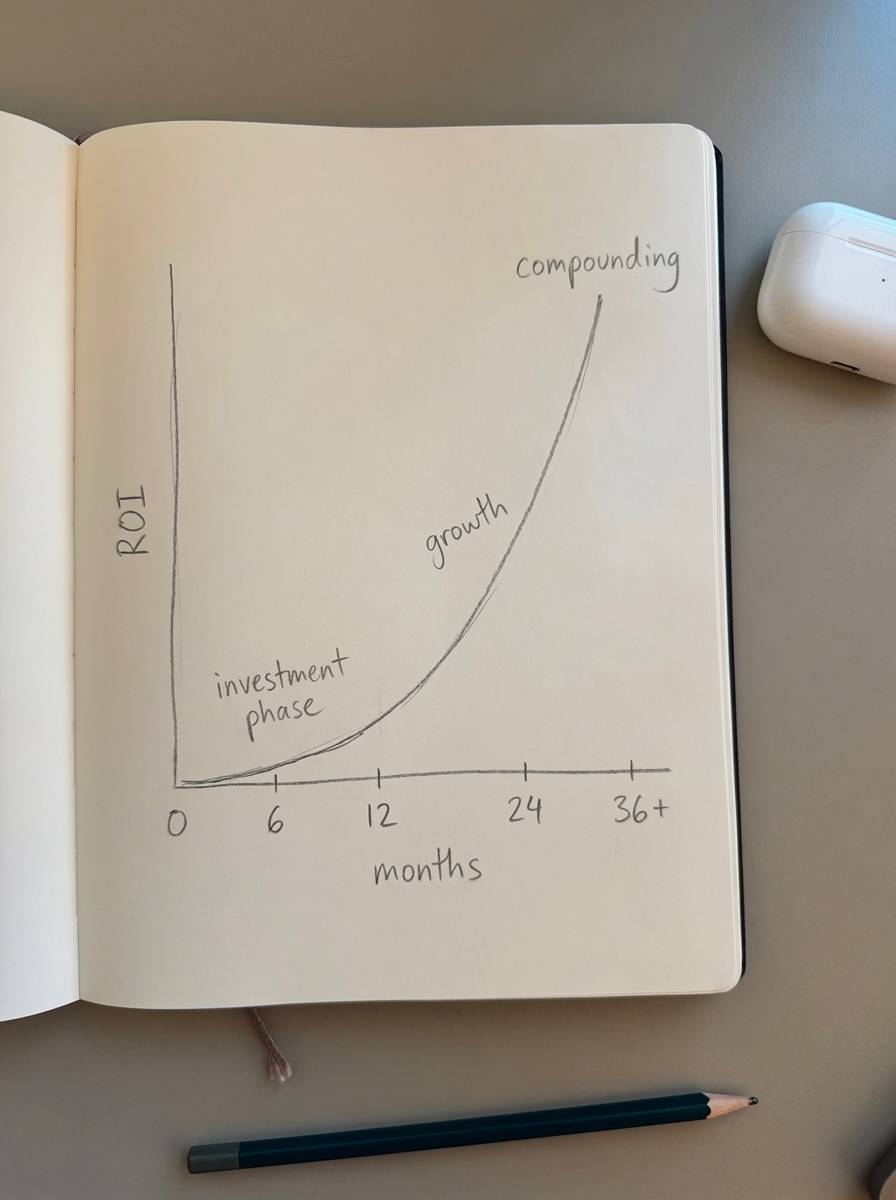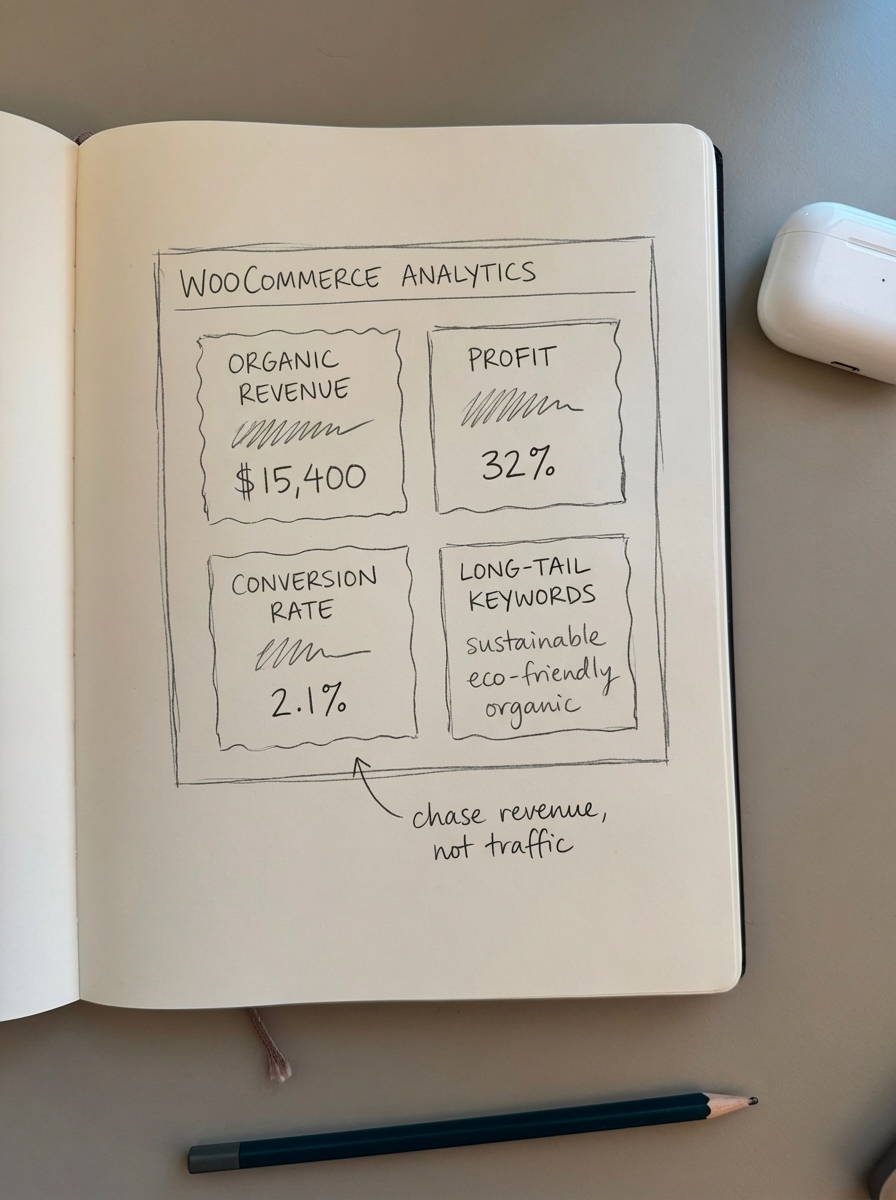WooCommerce SEO ROI: measuring and improving organic search returns
Most WooCommerce merchants track traffic and rankings but never connect those metrics to actual profit. That gap kills SEO budgets, and it’s fixable with the right measurement framework.
B2B ecommerce businesses derive 44.6% of total revenue from organic search – double the combined revenue from all other digital channels. Yet I’ve watched store owners celebrate “record organic traffic” months before discovering they were losing money on SEO. The problem isn’t the channel. It’s how we measure it.

The real cost of broken attribution
Traditional last-click attribution misses how customers actually buy. In 2025, LLM search traffic is projected to drive 75% of revenue, but AI-influenced demand shows up as “direct” traffic in your analytics. When someone reads about your products in an AI overview, searches your brand name directly days later, and converts – your dashboard credits “direct” instead of organic SEO.
32.4% of marketers now use multi-touch attribution models for organic search, with 20.6% building custom models to capture AI-influenced touchpoints. Without this infrastructure, you’re measuring half the picture and making budget decisions on incomplete data.
The stakes are higher than most merchants realize. A customer who discovers you via an organic blog post, returns through branded search, and converts through email was assisted by three touchpoints – all influenced by SEO. But last-click models credit only the final email, systematically undervaluing your organic investment.
Foundation: proper tracking infrastructure
Before calculating ROI, your measurement stack needs to work. Start here.
GA4 + Search Console integration
Link these platforms to combine visibility metrics – impressions, CTR, position – with behavior data like engagement, conversions, and revenue. Our GA4 and Search Console setup guide for WooCommerce walks through enhanced ecommerce tracking, product events, and proper attribution windows. Proper GA4 configuration can improve data accuracy by up to 30%.
Enhanced ecommerce events
Configure these critical events in GA4:
view_itemfor product page viewsadd_to_cartfor cart additionsbegin_checkoutfor checkout startspurchasefor completed transactions with revenue
Track these by traffic source. You need to know which organic landing pages drive product discovery versus which drive direct conversions. The difference matters for content investment decisions.
Revenue attribution by page type
WooCommerce stores have distinct page types with different SEO roles. Category pages drive discovery. Product pages close sales. Blog content builds authority and captures informational queries. Treat them separately.
The eCommerce SEO dashboard segments Search Console metrics by page type automatically, showing you which content types actually drive revenue versus vanity traffic. When category pages outperform products in impressions but underperform in conversions, you’ve found your optimization priority.
UTM governance and parameter tracking
Implement consistent UTM parameters for any external organic links – guest posts, directories, PR. Use utm_source=organic and utm_medium=seo with specific campaign tags. This separates earned SEO links from other organic sources in attribution.
Without parameter governance, that high-authority guest post driving $15K in monthly revenue gets buried in generic “organic” traffic alongside random blog comments and directory spam. Tag it properly and you can justify the $2K content investment.
Core ROI calculation framework
Here’s the formula that matters:
SEO ROI = (Revenue from Organic - Cost of SEO) / Cost of SEO × 100
The devil’s in the definitions.
Revenue from organic
Use GA4’s multi-touch attribution reports, not last-click. Look at direct organic conversions from last-click attribution, assisted conversions from first-click and mid-funnel touchpoints, influenced revenue using GA4’s data-driven attribution, and brand search lift as an indirect SEO impact.
For WooCommerce, segment by product category and margin. High traffic to low-margin products inflates vanity metrics while hurting actual ROI. I’ve seen stores celebrate 100K monthly blog sessions while losing money because 80% of that traffic landed on sub-10% margin categories with poor conversion rates.
Cost of SEO
Track everything: content creation including freelancers, staff time, and AI tools; technical fixes covering developer hours and agency fees; tools and software like rank trackers and SEO platforms; link building for outreach and guest posts; and platform costs including hosting upgrades for Core Web Vitals.
Proportional allocation matters. If 40% of your SEO effort targets blog content versus product optimization, allocate costs accordingly when measuring content ROI separately. Blended cost calculations mask which initiatives actually deliver returns.
Time horizons: the investment curve
SEO ROI follows a predictable curve that most merchants abandon too early. Based on tracking hundreds of WooCommerce stores:

- 0-6 months: 0.8x ROI during the investment phase
- 6-18 months: 2.6-3.8x ROI in the growth phase
- 18-24 months: 3.8-4.6x ROI at maturity
- 24+ months: 5.2x+ ROI with compounding returns
The exponential phase between 6-18 months is where most stores either scale or quit. Average ecommerce SEO ROI reaches 2.6x at 12 months and 5.2x at 36+ months when properly attributed. Stores that kill SEO programs at month 8 because they’re “only at 1.5x ROI” are walking away from 5x returns at month 24.
Advanced attribution in the AI era
Traditional metrics are breaking. AI Overview citations now achieve 38% citation frequency for optimized brands, correlating with 7% branded search lift and 5% direct session increases. But these conversions get misattributed as “direct” in analytics, making organic SEO look less valuable than it actually is.
Incrementality testing
Use controlled experiments to measure true lift. Deploy SEO optimizations in half your markets with geographic holdouts, then measure revenue differences. Track conversion rates before and after major SEO changes using time-series analysis with synthetic control groups. Segment users by exposure – saw AI overview versus didn’t – and track downstream conversions through cohort testing.
Case studies using difference-in-differences analysis show 7-9% incremental lift in assisted conversions from AI Overview visibility that wouldn’t appear in last-click models. That hidden lift might represent 15-20% of your actual organic revenue.
AI citation tracking
Monitor your brand’s appearance in ChatGPT responses, Google AI Overviews, Perplexity citations, and Gemini recommendations. Track correlation with branded search volume and direct traffic spikes. Brands implementing LLMO strategies report up to 43% organic traffic increases and 3-15% sales growth when including AI-influenced attribution.
I’ve tracked stores where AI Overview citations preceded 30-40% increases in branded search volume over eight weeks, with direct traffic (actually AI-influenced) growing proportionally. Without connecting these dots, attribution models credited “brand awareness” while undervaluing the SEO work that earned those citations.
Actionable metrics beyond vanity numbers
Focus on conversion metrics, not traffic
The #1 organic position captures 27.6% of clicks and top 3 results secure 54.4%, but position 5 with 8% CTR and 5% conversion rate outperforms position 1 with 28% CTR and 1% conversion rate on revenue.
Track organic conversion rate by landing page type, average order value from organic traffic, revenue per organic session, and customer lifetime value by acquisition source. I’ve seen stores with 50,000 monthly organic sessions generate less revenue than competitors with 5,000 sessions because the latter targeted high-intent commercial keywords while the former chased informational volume.
Long-tail keyword ROI
Long-tail queries typically convert 2-5% higher than short-tail generic terms. A B2B SaaS targeting “cloud-based project management tools for remote teams” saw a 40% increase in qualified leads with 3x higher average deal size compared to short-tail traffic.
Use GA4 custom dimensions to segment keywords by length – 3+ words equals long-tail – and track conversion rates separately. Intent-based keyword clustering using AI tools improves content relevance by up to 40% while reducing manual research from 20 hours to 45 minutes. The free SERP-based clustering tool groups keywords by search result similarity, helping you identify which clusters actually drive conversions.
Product-category performance
Not all categories deliver equal ROI. Create custom segments in GA4 like Landing Page contains /product-category/high-margin-category/ and compare organic traffic value by category against your gross margin data.
I’ve found stores wasting 40% of content budget on categories with negative contribution margin after SEO costs. One client spent six months optimizing content for a 5% margin category while ignoring a 40% margin category with identical search volume. Reallocating that budget tripled their organic profit within four months.
Technical SEO’s impact on ROI
Technical fixes often deliver the fastest, most measurable ROI improvements.
Core Web Vitals optimization
Pages meeting Core Web Vitals consistently outrank poorer pages, and site speed directly impacts conversion. A one-second improvement in page load time can increase conversion rates by up to 27%. For a store doing $100K monthly organic revenue, that’s $27K in additional revenue from a technical fix.
Prioritize by traffic impact. Fixing slow product pages with 10,000 monthly sessions beats optimizing fast blog posts with 500 sessions. Technical SEO fixes like resolving keyword cannibalization issues can generate 2,172+ additional monthly clicks within weeks. Learn more about page speed optimization strategies.
Schema markup ROI
Implement product, review, and FAQ schema on WooCommerce pages. Proper schema increases CTR for featured snippets by 42.9%. A store ranking #3 with 8% organic CTR can jump to 12-15% CTR with featured snippet capture, purely from schema optimization.
Track this in Search Console by filtering for “Rich results” and measuring CTR before and after implementation. I’ve tracked 15-25% CTR improvements from schema alone on pages that already ranked well, with zero change to actual rankings.
Fixing keyword cannibalization
Multiple pages competing for the same keyword split ranking signals and depress all pages’ performance. Consolidate or differentiate cannibalized content.
One store consolidated five similar “leather bags” category pages into one comprehensive page with filtered navigation. Result: position jumped from 8-12 to position 3, with 340% increase in organic category revenue in eight weeks. The SEO cost was two days of developer time.
Content optimization for ROI
Prioritize by revenue potential, not traffic potential
Rank content opportunities by search volume × average order value × organic conversion rate × position-based CTR.
A keyword with 500 monthly searches, $200 AOV, 4% conversion rate, and realistic position 3 ranking with 10% CTR is worth 500 × 0.10 × 0.04 × $200 = $400 per month or $4,800 per year. Compare that to a 10,000-volume keyword with $50 AOV and 1% conversion rate – same revenue potential but 20x the ranking difficulty.
Chase revenue, not volume. The ROI-focused SEO content strategy guide explains how to build content frameworks that prioritize commercial value over traffic.
Update existing content, don’t just create new
Companies using AI tools for blog scaling report 40% higher organic traffic within six months, but I’ve found updating existing top-20 ranking content – positions 8-20 – delivers faster ROI than creating new content from scratch.
Target pages ranking positions 4-10 in Search Console. These are low-hanging fruit needing optimization, not authority. Update word count, add product examples, improve internal linking, and refresh images. One case study showed 2,172+ monthly clicks gained from systematically updating underperforming content. Automate SEO reporting to identify these opportunities faster.
Product-aware content that drives conversions
Generic buying guides don’t convert. Content that references your actual catalog, current pricing, and stock availability does. This is where catalog-synced automation matters. Manually updating 50 blog posts every time SKUs change isn’t scalable.
ContentGecko automatically syncs product data including prices, SKUs, and availability, updating content when products change and creating strategic internal links to high-margin products. This keeps content accurate and conversion-focused without manual maintenance. The WordPress connector plugin enables automated blog post creation with product-aware content.
Reporting cadence for continuous improvement
Build measurement into regular reviews.
Weekly tactical reviews

Track ranking changes for money keywords, traffic anomalies requiring investigation, conversion rate by top landing pages, and new ranking opportunities like queries entering top 20. Automated SEO reporting saves 10+ hours weekly while providing these insights.
Monthly operational reviews
Monitor organic revenue versus target, AOV and conversion rate trends, top 10 revenue-generating pages, and content performance by category. Use Google Analytics SEO reports to track engagement metrics and conversion paths that link search visibility to business outcomes.
Quarterly strategic reviews
Calculate full ROI including profit margins and LTV. Compare channels – organic versus paid versus email. Analyze competitive SERP share, identify content gaps, and adjust roadmaps. Conduct technical SEO health audits to catch issues before they impact revenue.
Yearly executive reviews
Review multi-year ROI trends, market share shifts, strategic positioning, and budget allocation. Forecast based on historical growth curves and the 2.6x-to-5.2x ROI progression over 36 months.
Use data visualization for SEO reports to communicate performance to stakeholders who don’t speak SEO. Executives care about revenue attribution charts, not keyword rankings.
Common ROI calculation mistakes
Ignoring mobile segmentation
Mobile commerce is growing 25% year-over-year but often converts at 40% lower rates than desktop. If you’re measuring blended conversion rates without device segmentation, you’re missing optimization opportunities.
Pages with poor mobile UX tank overall organic ROI despite strong desktop performance. I’ve seen desktop conversion rates at 4.5% and mobile at 1.2% on the same pages – blended rate of 2.8% masked which device needed work.
Using static timeframes
Comparing January to February ignores seasonality. Always use year-over-year comparisons for ecommerce SEO metrics. A “10% traffic drop” in January compared to December might actually be 15% growth year-over-year.
Misattributing brand search
Organic brand searches should be partially credited to SEO efforts that built brand awareness, not treated as separate “direct” traffic. Track brand search volume trends alongside non-brand organic performance. SEO success often shows up as brand search growth before ranking improvements.
Ignoring profit margins
Revenue ROI looks great until you calculate profit ROI. A category generating $50K monthly organic revenue with 10% margins – $5K profit – and $8K monthly SEO costs has negative ROI despite positive revenue growth.
Always calculate (Profit from Organic - SEO Cost) / SEO Cost. Revenue vanity metrics have killed more SEO programs than algorithm updates.
Automation and AI for scalable ROI tracking
Manual reporting doesn’t scale. Automated SEO reporting with AI tools saves 10+ hours weekly while enabling up to 10x organic traffic growth.
Anomaly detection
Set up automated alerts for ranking drops greater than 5 positions for revenue-generating keywords, traffic drops greater than 20% week-over-week, conversion rate drops greater than 15% by landing page type, and sudden increases that might signal algorithm updates or competitor drops.
Automated anomaly detection in SEO platforms provides immediate alerts so you respond to changes in hours, not weeks. I’ve recovered traffic drops within 72 hours using automated alerts that would have taken two weeks to discover manually.
AI-powered content optimization
52% of SEO experts report performance improvements using AI for on-page optimization. One financial services firm scaled from 5 to 50 monthly pieces using AI-guided optimization – a 10x increase in production capacity with improved quality.
Use the free AI SEO content writer for first drafts, then refine with product-specific details and brand voice. This reduces content creation time by 50-75% while maintaining conversion focus.
Catalog-synced automation
For WooCommerce stores, the ROI multiplier is keeping content synchronized with inventory changes. Out-of-stock products mentioned in blog posts, outdated pricing in buying guides, discontinued SKUs in internal links – these conversion killers compound over time.
ContentGecko builds automated content planning and execution synced to your product catalog, with ongoing monitoring and updates when SKUs, prices, stock, or URLs change. Real-time performance tracking by category with conversion tracking tied to catalog means you always know which content drives revenue and which needs optimization.
The path forward: building a revenue-focused SEO program
Start with measurement infrastructure. Without proper GA4 and Search Console configuration, you’re flying blind. Combining Google Analytics and Search Console data creates the unified data ecosystem needed to link search visibility to user behavior and conversions.
Then implement a reporting cadence that connects organic metrics to business outcomes. Weekly tactical reviews catch issues fast. Monthly operational reviews identify trends. Quarterly strategic reviews allocate resources to high-ROI initiatives.
Focus optimization efforts on high-ROI opportunities: technical fixes for high-traffic pages, content updates for positions 4-10, product-aware content that references actual catalog. Track everything by profit, not just revenue.
Remember the time horizon. Average SEO ROI reaches 2.6x at 12 months and 5.2x at 36+ months. Most stores quit in the 0-6 month investment phase and never see the exponential returns.
Explore our case studies to see how WooCommerce stores measure and improve SEO ROI at scale. Or read more about measuring the ROI of long-tail SEO campaigns for specific tactics on high-conversion keyword strategies.
TL;DR
Measuring WooCommerce SEO ROI requires proper attribution infrastructure – GA4 plus Search Console integration, enhanced ecommerce tracking, and multi-touch attribution that captures AI-influenced conversions. Focus on profit-based metrics over traffic vanity numbers. Understand SEO’s 6-18 month exponential growth phase where ROI jumps from 0.8x to 3.8x. Technical fixes like Core Web Vitals optimization deliver fast, measurable returns. Long-tail keywords convert 2-5% higher than generic terms. Product-aware content synced to your catalog drives conversions better than generic buying guides. Automated reporting saves 10+ hours weekly while enabling faster optimization decisions. Average ecommerce SEO ROI reaches 2.6x at 12 months and 5.2x at 36+ months when measured correctly – making it the highest-ROI digital channel for most WooCommerce stores.
